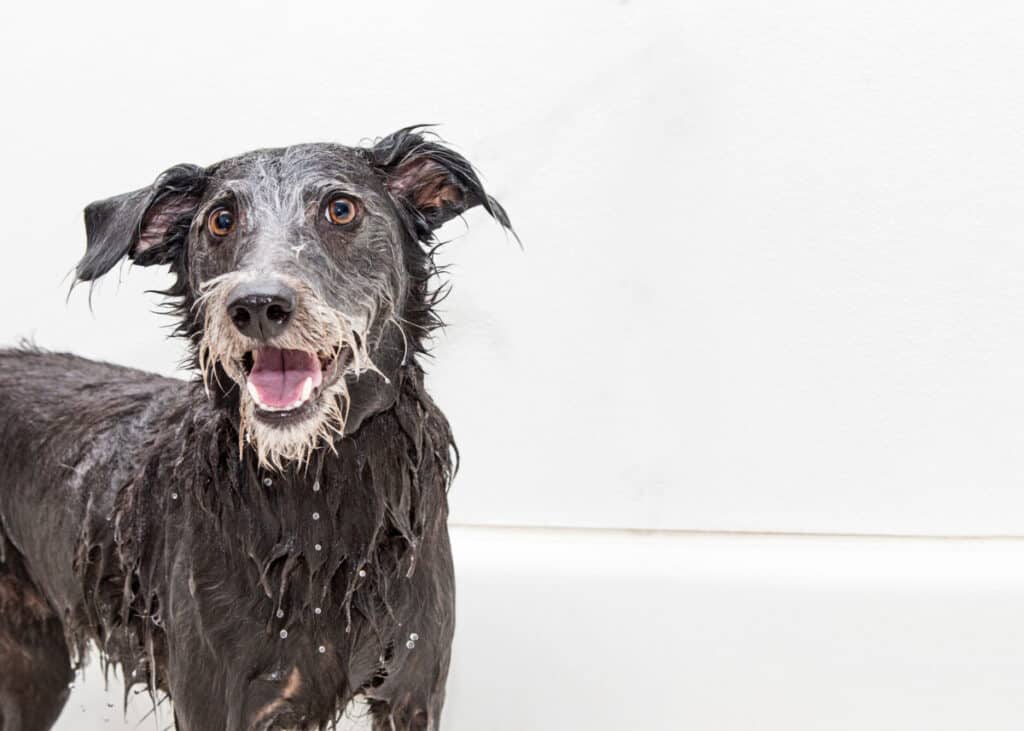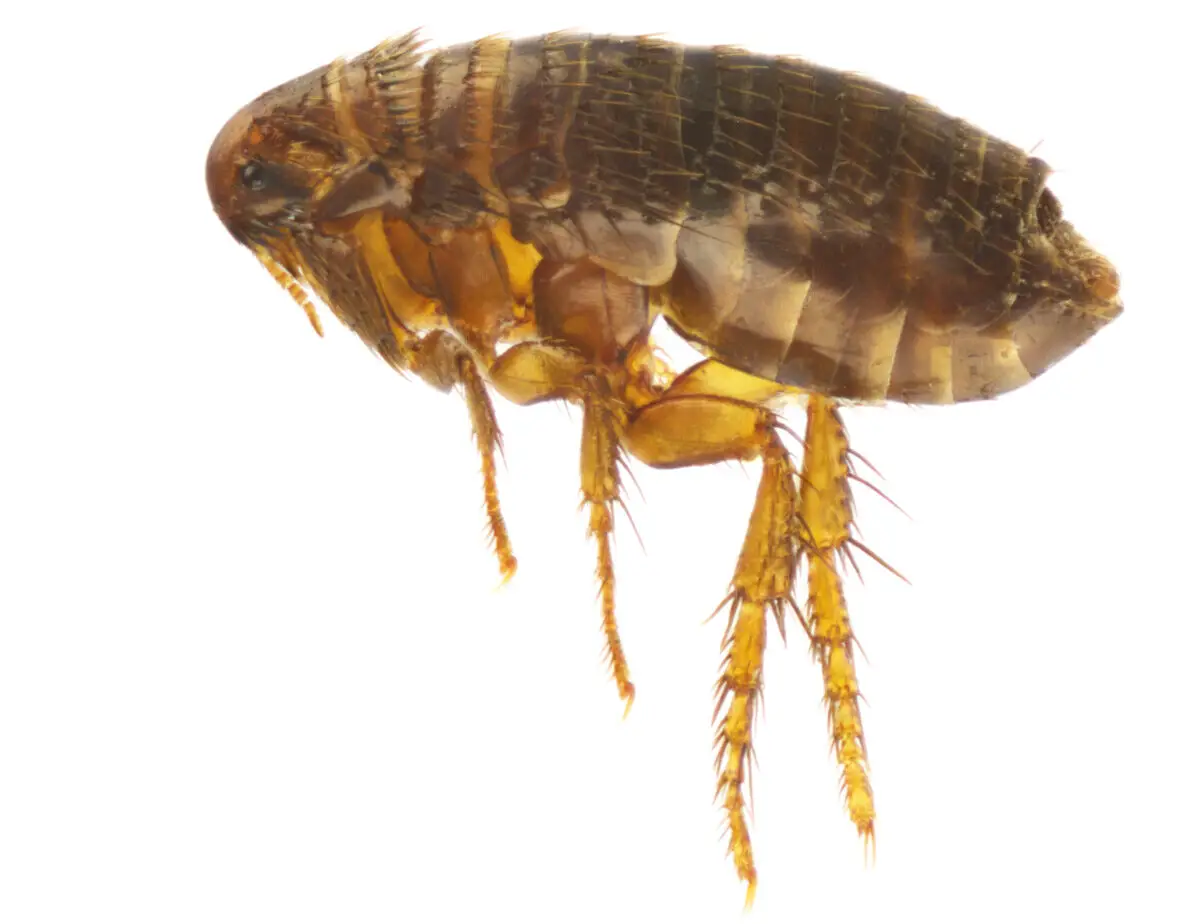Affiliate Disclosure: This post may contain affiliate links. If you make a purchase after clicking on these links I will be compensated at no extra cost to you. However, I never recommend anything I don’t love or wouldn’t use myself!
Fleas are horrible little pests that can cause issues even in the absence of pets. They are a general annoyance and they can even pose health risks for us humans. You might wonder just how long they can survive in your house without a host?
Adult fleas can survive 4 to 7 days without a host before dying of starvation. Flea eggs, larvae, and pupae do not rely on fresh blood and take much longer to die out. Flea pupae have the greatest longevity and given the right conditions can last 155 days if undisturbed without a host.
Most people are not comfortable with riding out a flea infestation. Fleas can be extremely persistent and will usually require a more hands-on intervention. In this article, we will cover why fleas are so persistent, how they get into our homes, and how to get rid of them as soon as possible!
How Long Fleas Live at Each Life Stage
If you know or suspect that you have a flea problem, it is important to know more about them and how their life cycle works. This information can help you decide how to best treat fleas and remove them from your living space.
Adult fleas typically live 30-90 days on average with a host. Without, their life span is much shorter, however, fleas pass through four stages of life, including egg, larva, pupa, and adult.
Each phase has its own characteristics and can survive for varying periods of time without a host. Let’s cover each life stage, how long they can survive with/without a host, and the reasons why.
How Long Do Flea Eggs Live Without a Host?
An adult female flea will lay 20 to 30 eggs on average per day while she is feeding off a host, with some laying even more.
The eggs will usually fall off the host and are dispersed around the home, particularly where the host spends the most time. The eggs then hatch into larvae 1-12 days after being laid and do not need a host to survive.
How Long Do Flea Larvae Live Without a Host?
After hatching from their eggs, larvae emerge. Larvae resemble small pale worms that are only two to five millimeters in length.
Larvae feed off the excrement of adult fleas as well as other pieces of organic material, including dead skin and food particles.
This means that larvae also do not need a host for survival. They will continue to progress and grow for the next 4-18 days until they mature enough to transform into the next stage.
How Long Do Flea Pupae Live Without a Host?
As flea larvae transform into pupae, they cocoon themselves into a silk-like structure where they hibernate until such time as they’re properly developed and can sense a host.
The pupa stage is when a flea can survive the longest without a host, up to 155 days. This is important to understand when treating fleas. They may appear to be gone, but if there are pupae, fleas are likely to return.
How Long Do Mature Fleas Live Without a Host?
Once the pupa senses a host, it emerges from its cocoon as an adult flea. This is the last stage of a flea’s life. During this period it is fully dependent upon finding and feeding on a host.
Newly emerged fleas may only survive up to a week if they do not find a host. Meanwhile, if a more mature flea is removed from its host then it may only survive up to four days.
With a host, a female flea can breed and start laying eggs after only a day or two.
How Long Can Fleas Live In Your Carpet/Furniture?

To answer this question, we need to combine the time from when an egg is laid until it hatches, pupates, and then dies due to the lack of a host. So…
From the moment their life cycle begins as an egg, fleas can survive a total of 185 days in carpets and furniture if undisturbed and in favorable conditions. This factors in the 3 life stages in which fleas do not require a host. Adult fleas on the other hand will die of starvation within a week.
In order for fleas to survive this long (1-12 days as an egg, 4-18 days as a larva, and 155 days as a pupa) the environment must be just right at every stage. This includes larvae being able to feed on enough flea dirt and dead skin cells to pupate.
Nonetheless, it gives you a pretty good estimate of what you can potentially be dealing with. 185 days is equivalent to a little over 6 months.
How Do Fleas Get Into Homes?
While not the only reason, the most common cause for a flea infestation in your home is due to pets. Our adorable animal companions can often bring some not-so-cute friends home with them.
Cats and dogs that go outside often and play in long grass, grass clippings, or woodpiles are more likely to bring fleas into your home.
If your pet plays near these places where fleas often reside, or near other infested animals, the fleas may jump onto your pet.
How Do Fleas Get Into Homes Without Pets?
If you do not have a pet, fleas may be introduced to a house via rodents, squirrels, bats, and various types of vermin. Alternatively, they may enter through infested old furniture, cracks in floors, windows, or even via humans.
While fleas do not usually live on humans, they may use you as a temporary host or as a means of traveling to a more desirable furry host.
You may have fleas in your home if:
- You find clusters of red, itchy bites on around your ankles or on your pet
- You find black or white specks (flea dirt or eggs)
- You can see them! If you see little hopping bugs, they’re likely to be fleas
- Your pet is excessively scratching them self
- Your pet loses hair due to scratching or an allergic reaction to fleas
- Your pet has pale-colored gums due to lack of blood flow caused by flea bite anemia
Where Do Fleas Prefer to Live?
Fleas can not survive in extreme temperatures; hot or cold. They also prefer high humidity. Pet beds, or areas where vermin may reside are where flea eggs are most commonly found.
Even if you have removed your pet and/or exterminated any vermin in your home, failure to remove all eggs, larvae, and pupae may allow the fleas to continue to hatch.
We, humans, are certainly not their first choice of residence due to our lack of fur. In fact, fleas survive even longer on long-haired animals as opposed to short-haired ones.
Additionally, most fleas require a host with fur or feathers in order to breed, so without they will not be able to produce any new offspring.
How to Treat a Flea Infestation
Getting rid of fleas is crucial for keeping you, your family, and your pets healthy, as well as for your own sanity!
There is a difference between spotting a couple of fleas and having a severe flea infestation. But even small signs of fleas should be treated as thoroughly as a full-blown infestation to be sure of success.
Treat Your Pet (If You Have One)

Granted if you’re reading this article, you may not actually own a pet. However, if you do, the first and most crucial step for ridding your home of fleas is to clean and treat your pet.
There are many different flea removal shampoos and treatments for both cats and dogs. However, if you do not have any, regular pet shampoo or anything that produces a lather will do.
Diligently, deep clean your pet’s fur. In the case of young puppies that are too young to be bathed, there are special flea combs that you can purchase to get any clinging eggs or fleas out of the fur (very similar to removing lice from your hair).
After cleaning your pet, the best way to prevent them from becoming reinfested is to treat them using topical/spot-on treatment such as Frontline (Amazon).
This will kill any fleas that come into contact with your pet for at least four weeks, effectively cutting off any remaining fleas from their primary food supply and also from their ability to breed.
Surprisingly, treating a flea infestation in the home can actually be easier if you have a pet. This is because they will act as both bait and poison for any fleas.
Clean Your Home
A huge part of successfully getting rid of fleas is cleanliness. Deep clean your home to get rid of any eggs, larvae, pupae, or roaming fleas that could be hiding. These are the main reason for flea infestations persisting.
Vacuum
Start by using a powerful vacuum on all floors, carpets, upholstery, and mattresses. Make sure to get any cracks or tight spaces that eggs could have fallen into.
When you have finished with the vacuum, dispose of the contents outside of your home and be careful not to come into contact with the contents.
As well as physically removing the fleas, vacuuming will signal to flea pupae that a host is nearby, and will bring them out of their dormant state.
Repeat this process as regularly as possible for at least a couple of weeks for the best chance at catching fleas in their various stages of life.
If you have a pet then be sure to focus on the areas where your pet spends the most time. Vacuum these areas at least once daily.
Steam Clean
Heat and soap can kill fleas in all stages of life. If you own a steam cleaner, this is a great way to kill anything you weren’t able to vacuum out.
It’s perfect for any hard-to-reach nooks and crannies and can also be used on carpets and upholstery.
If you do not have a steam cleaner, don’t worry too much. Just keep repeating the vacuuming process frequently over the next couple of weeks to catch any fleas that you missed.
Wash Bedding and Upholstery
Fleas at various stages of their life cycle are likely to be hiding in your bedding and upholstery. Probably the most reliable way to kill fleas in these areas is to wash all bedding and upholstery in the washing machine.
Washing detergent will do a pretty good job at drowning fleas at any stage in their life cycle, but for the best possible result, use a hot wash above 140°F/60°C and also tumble dry the items.
If you have a really bad infestation, consider throwing away old bedding entirely.
If you have pets then spend the most time on the pet’s bedding, toys, and favorite resting places. That is where most eggs, larvae, pupae, and fleas will be.
Treating Outside Areas
This step is often not as important as the others, but fleas can make their way into your home from outside. You can help to prevent this by making your yard less tempting for fleas.
Fleas like long grassy areas and damp areas such as woodpiles. Keep your lawn short and your yard tidy to reduce the chances of fleas moving in.
Diatomaceous earth is a natural powder that can be used to kill fleas both inside and outside of your home. Ensure that you are using food-grade Diatomaceous Earth (view on Amazon) as opposed to the stuff that is used for swimming pools.
Simply shake a thin and even layer over the area you are trying to treat. This will lacerate the exoskeletons of insects and spiders and will draw the moisture out of them.
Bear in mind that if outside and it rains, the diatomaceous earth will no longer be effective.
If you are using diatomaceous earth inside your home, simply vacuum the powder back up after two or three days.
Use Flea Repellent Plants and Devices
When dealing with fleas, a multifaceted approach is often the best. While I wouldn’t rely exclusively on this approach, you may want to invest in an ultrasonic pest repelling device (view on Amazon).
These products emit a high-frequency audio signal that cannot be picked up by the human ear but will deter fleas and other insects.
Additionally, for a more natural approach, you can also get some flea repelling plants placed in strategic areas around your home. The plants listed below are non-toxic for pets.
Non-toxic flea repelling plants include:
- Catnip
- Chamomile
- Chrysanthemums
- Lavender
- Lemon Grass
- Marigold
- Mint
- Rosemary
- Sage
Fleas do not like the scents of these plants and will tend to avoid them.
Chemical Treatments and Exterminators

There are also chemical treatments usually in the form of sprays for use around the home (view on Amazon) to kill fleas at any stage of life. Make sure to follow directions carefully, as most of these chemical treatments are harmful to people and pets too.
The last way to remove fleas from your home is to call an extermination service and let them do a full house treatment for you. Although these can be expensive, it is the most thorough way to ensure no more fleas will be bothering you or your pet.
In Conclusion
Fleas can be a nuisance whether you have pets or not. Unfortunately, you will need to take action to rid your home of fleas, and following the steps above should help with that.
Fleas pose health risks to pets and humans alike so it is in your best interest to do so.
For more information on fleas and their interactions with humans, and how to prevent yourself from being bitten, be sure to check out my article What Attracts Fleas to Humans and How to Protect Yourself.

